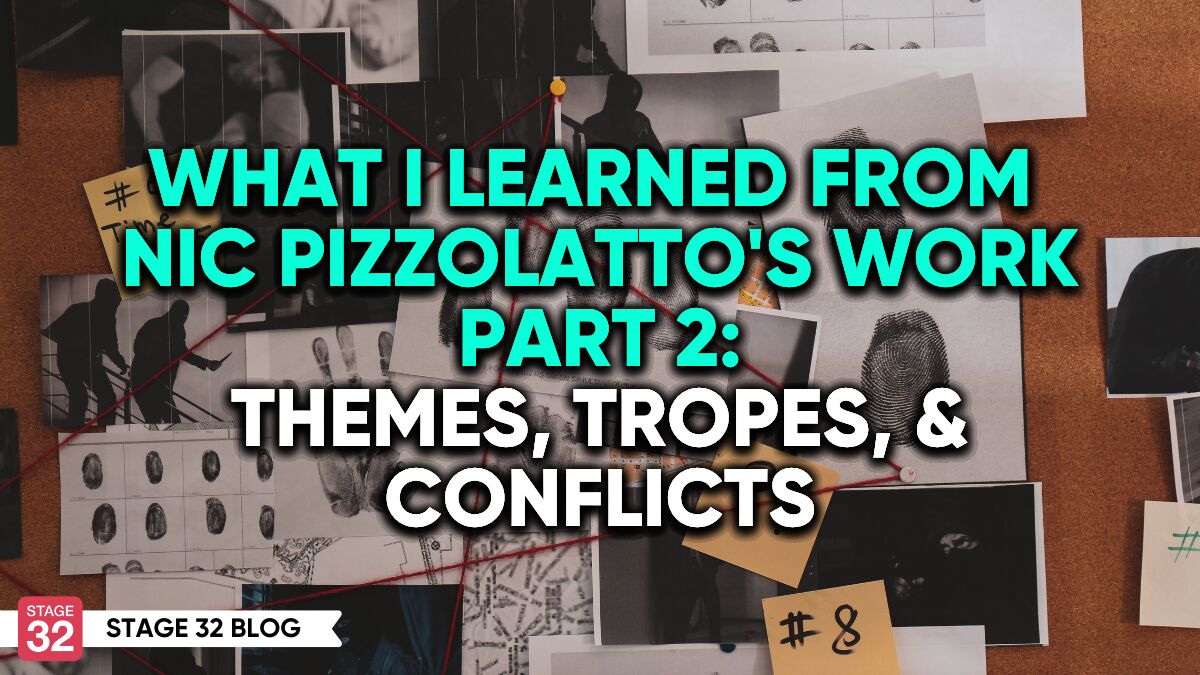What I Learned From Nic Pizzolatto's Work Part 2: Themes, Tropes, and Conflicts
In part 1 of this blog series (which you can find HERE), I delved into character and plot development inspired by Nic Pizzolatto's work. Now, let's focus on content aspects: themes, tropes, and conflicts. Unlike the first part, there's no specific order here—it's a writing toolbox to be used as needed.
- Themes are the flesh of a story, giving it depth beyond the plot. They offer an interesting perspective on everyday life, resonating with audiences long after the story ends. For example, True Detective's overarching theme explores how people with personal issues navigate a dark world.
- Tropes, though recognizable, can add depth when connected to a theme. They're part of our storytelling arsenal, offering an unexpected recombination of familiar elements that surpasses clichés. Choose them carefully to fit your story's tone.
- Conflict is essential for a compelling plot. Beyond the basic conflict, characters' psyches and moral compasses can spawn additional, nuanced conflicts and organic subplots.
Now, let's examine what makes Pizzolatto's stories unique—a blend of themes, tropes, and conflicts.
Genre Mix:
In True Detective's first season, we encounter a blend of buddy cop, neo-noir, philosophical nihilism, cosmological horror, and Southern Gothic. This unique fusion of genres yields something refreshingly new, leveraging the familiarity of each genre while creating an innovative whole. Rather than replicating Pizzolatto's mix verbatim, the key is to experiment with genres in a manner that suits your narrative. Whether it's action, crime, thriller, horror, satire, or any other genre under the sun, there are no boundaries to your creativity. The crucial aspect is to seamlessly integrate your characters, plot, and themes with your chosen genre mix.

Partners With An Ambivalent Relationship:
Pizzolatto's stories stand out from conventional buddy narratives due to the complex dynamics between his protagonists. These relationships often endure over decades, marked by a blend of enduring connection and intense conflict. This dynamic not only impacts the main characters but also ripples through their familial, professional, and social spheres. Partnerships range from overt hostility to deep friendship or even romantic entanglement, all underscored by a profound emotional, intellectual, or professional dependency. The characters' strengths, weaknesses, motives, and fears are laid bare, reflecting a shared history of obligation or guilt. They are intertwined in a way that they can't live with each other, but they can't live without each other either — a dynamic that evolves over the course of the narrative.
Symbols:
Symbols serve as powerful tools to deepen the thematic resonance of a story and illuminate the inner journey of its characters. Drawing inspiration from depth psychology and humanity's mythological traditions, symbols offer an inexhaustible wellspring of creative potential. In True Detective's first season, the recurring motif of the spiral manifests across various temporal layers, from tattoos adorning characters' skin to cosmic visions experienced by Rust Cohle. This symbol, reminiscent of Robert W. Chambers' "yellow symbol" from The King in Yellow, encapsulates the protagonists' descent into darkness. Rust's own affinity for symbolism, evidenced by his possession of the Book of Symbols from the Archive for Research in Archetypal Symbolism (ARAS), underscores its thematic significance. Experimenting with different symbols can enrich storytelling, offering new avenues to structure and enrich your narrative.

Subjectivity Of Time:
Exploring the subjectivity of time through narrative jumps offers a profound exploration of life's trajectory, delving into the essence of humanity itself. It prompts viewers to ponder the nature of personal transformation and the continuity of identity. Questions arise about the extent of individual change over time and the interplay between past, present, and future selves. Does revisiting one's younger self reveal immutable truths or the potential for evolution? Are our destinies predetermined, or do we possess agency to forge new paths? The concept challenges us to reflect on the cyclical nature of existence, echoing Nietzsche's notion of eternal recurrence. If faced with the prospect of eternal repetition, would we alter our choices or embrace the inevitability of fate? These philosophical inquiries enrich storytelling, inviting audiences to contemplate their own existential journey and the timeless mysteries of existence.
Lack Of Separation Between Work & Free Time:
The blurring of boundaries between work and personal life is a relatable struggle for many, particularly in today's interconnected world. When characters grapple with this issue, it enhances their relatability and deepens the dynamics between them. Imagine a protagonist who not only hunts murderers but also struggles to carve out a semblance of a private or family life amidst the chaos of their profession. This tension impacts their relationships, from love interests to friendships and even interactions with neighbors. Psychological strain stemming from work-related stress can further complicate matters, potentially hindering their ability to form meaningful connections. Some may resort to unhealthy coping mechanisms like alcohol or drug use to numb the pressure. Importantly, these challenges are universal—whether the characters are law-abiding citizens, law enforcement officers, or criminals, the struggle to balance work and personal life is a human experience that transcends societal roles.

Sexual Complications:
Human sexuality is a nuanced and intricate aspect of humanity, encompassing a wide spectrum of experiences and emotions. It can be fulfilling, vexing, and even terrifying. For individuals who identify as asexual, navigating social expectations regarding sexuality can pose unique challenges. It's imperative to treat characters' sexualities with sensitivity and depth, considering how their desires and experiences shape their relationships and personal journeys. Complications such as suppressed desires, involuntary abstinence, infidelity, and sexual dysfunction can add layers to character dynamics and plot developments. Sexuality can also serve as a catalyst for personal growth, offering characters opportunities for self-discovery and newfound confidence.
Crumbling Facade:
In the realm of horror and weird fiction, characters often confront a world that is far from what it appears to be. Society's decay is palpable, manifesting in the deteriorating facades of both people and structures, especially in the fringes of civilization. Even in seemingly idyllic settings, signs of decadence and grotesque anomalies abound. As protagonists navigate this unsettling landscape, reality blurs with imagination, making it increasingly challenging to discern truth from illusion. The world teems with age-old secrets and tragedies, prompting existential questions about its true nature. Is it merely a fragile facade hiding deeper, darker realities? Perhaps behind the illusion lies a terrifying abyss of nothingness. The looming uncertainty adds a metaphysical dimension to the characters' journey, leaving them to grapple with the unsettling possibility of the illusion's complete dissolution. Until that moment arrives, they must confront the terror of living in a world fraught with uncertainty.

Landscapes & Environmental Storytelling:
Landscapes and environmental storytelling play a vital role in shaping the world of our story. They aren't just backdrops for visually stunning shots; they are integral components of the narrative. Just as people mold the landscapes they inhabit, the landscapes, in turn, shape the inhabitants. This dynamic interaction between nature and civilization is most pronounced in border areas, where wild terrain meets human settlement. Here, communities may have their own unique customs and traditions, often viewing outsiders with suspicion. Danger lurks in the form of wild animals or poisonous plants, adding to the sense of peril. The landscape itself can be labyrinthine, dotted with barriers and potential hiding spots, creating an atmosphere of mystery and intrigue.
Following the principle of "Show, don't tell," we can convey the history and essence of a place without using words. Footprints leading to a secluded pool, an extinguished campfire surrounded by discarded packaging, a wrecked car abandoned beneath a tree with an empty whiskey bottle on the seat—all these silent clues speak volumes about the events that transpired there. While this storytelling technique is commonly associated with open-world video games, its application extends seamlessly to traditional entertainment media like films and series.

Ultimately, landscapes serve not only as visually captivating settings but also as active participants in the narrative, embodying their own stories and adding depth to the overall storytelling experience.
While these examples offer a solid foundation, there's undoubtedly more to explore. I'm certain many of you have your own ideas about additional tools gleaned from True Detective and other high-quality series. Remember, the value of these tools lies in how you use them. So let's dive in and start writing!
Let's hear your thoughts in the comments below!
Got an idea for a post? Or have you collaborated with Stage 32 members to create a project? We'd love to hear about it. Email Ashley at blog@stage32.com and let's get your post published!
Please help support your fellow Stage 32ers by sharing this on social. Check out the social media buttons at the top to share on Instagram @stage32 Twitter @stage32 Facebook @stage32 and LinkedIn @stage-32
| PR Pro Lingo: 25 Terms Filmmakers and Actors Must Know! |
| How Stage 32 Got My Work In Front Of The Right People & Connected Me With My New Manager! |
Search Stage 32 Blog
There are now 4040 blog posts for you to enjoy. Search them all by tags below.
Acting, Advice, Cinematography, Coffee & Content, Composing, Contests, Distribution, Featured, Filmmaking, Financing, Inspirational, Networking, Producing, Screenwriting, Success Stories, Tips, Trending,Relevant Tags
Recommended Articles

How Stage 32 Script Services Make You A Better Writer

How Modern Franchises Became Our New Religion

A Practical Guide for Actors: Tips & Advice Every Performer Should Know

Insider Intel: 2025- Your Year of Breakthroughs (+ What's Coming in 2026)

Coffee & Content: The Genius of Weapons and How to Know When Your Script Is Ready

7 Life Hacks For Creatives

Coffee & Content: Why Your Next Step Matters More Than the Perfect Step

Find Your Footing on Stage 32: Join Our December Community Open House

State of the Industry 2026 Now On-Demand: RB & Geoff Break Down What’s Next for Writers!






